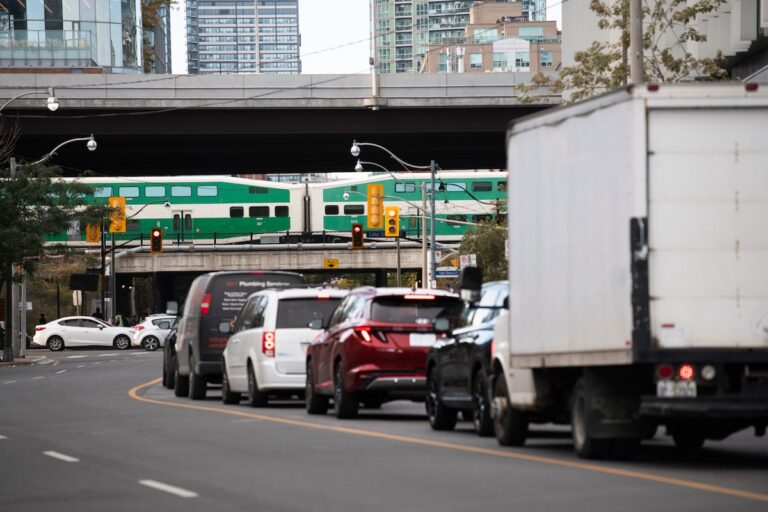Open this photo in gallery:
A GO train heading from Queens Quay East to Union Station in Toronto passes northbound traffic on Lower Jarvis Street before entering the ramp to the westbound Gardiner Expressway, causing traffic congestion on Sept. 27, 2023. Fred Lam/The Globe and Mail
Every time I come back from a trip to Europe I feel a little embarrassed. Embarrassed and confused. Why is everything so much better there? The parks, the public transport, the highways, the squares, the museums, even the trash cans. Better than ours.
Arriving in Toronto, where I live, feels like crossing from the West into the East during the Cold War. Everything looks shabby. The main road from the airport into downtown is in awful condition. Rusty guardrails. Trash and weeds on the shoulders. The road has holes and bumps. The drive downtown along the Gardiner Expressway feels like a ride on a decrepit roller coaster.
And let’s not forget, this is the gateway to Canada’s largest and wealthiest city – what kind of first impression does this make on visitors? Why can’t we do something as simple as routine maintenance on a major road?
Spain’s highways, which we visited last month, are far better designed, engineered and maintained. A standard European signage system means it’s almost impossible to get lost. Even smaller roads are equipped with cat’s eye and other reflective markers, making them much safer at night than our less well-marked roads. Medians and shoulders are adorned with carefully trimmed greenery; when we visited, oleander bushes were just beginning to flower.
Public transportation in European cities is on a whole other level than ours. Madrid is about the size of Toronto, but its subway system is at least four times larger, with 15 lines and over 300 stations. The subway is clean, fast, and easy to transfer between. It connects to a comprehensive system of light rail, commuter rail, rapid rail, and buses (many of them fully electric). Building new subway lines is notoriously fast and cheap, by North American standards.
Even small cities like Porto, Portugal, have modern, efficient systems. Porto is in the midst of a major expansion, with construction cranes everywhere.
The parks are incomparably better, too. Toronto has an extensive park system, many of which are beautiful, but none of them come close to Madrid’s spectacular Retiro Park, a 350-acre gem of rose gardens, artificial lakes, and flowering chestnut trees. Toronto’s jewel, High Park, is noticeably shabby in comparison, as is downtown’s bustling but unkempt Trinity Bellwoods.
Efficiency experts at the Toronto Park Board have decided that rolling plastic bins, like the ones you get at curbs, would be a good idea for the park. Sure, they’d be easy to throw trash in, but they’d look horrible. Imagine the Retiro groundskeepers putting up with those? It’s unthinkable.
In Toronto, work is underway to replace trash bins across the city after the old ones tended to break and overflow. How can we not even get trash bins?
There is no excuse for such failure. Canada is a wealthy country. With higher incomes and higher taxation than Spain or Portugal, our government has ample capacity to build and maintain public spaces in our cities.
Certainly, the historical legacy of a grand old city like Madrid works in their favor — the Retiro was a royal park before the monarchy handed it over to the masses — but Toronto is no ordinary city. It has a rich history, a wealthy elite, and a strong city government with a deep budget. The mayor is elected by the public, giving him great powers of leadership.
And yet somehow it feels like no one is taking responsibility. We stumble along, missing huge opportunities to get it right every year, watching things fall apart. Toronto transit can’t even get its notoriously delayed Eglinton Crosstown Line up and running amid a belated, multi-billion-dollar expansion.
The redevelopment of the waterfront is well underway, but it’s missing a big idea to bring it all together — a harbor pier, a famous park, a major public market — and our two most important museums, the Art Gallery of Ontario and the Royal Ontario Museum, have each fallen into a bit of disrepair after decades of piecemeal renovations.
Any city with self-respect and serious leadership would not have allowed this to happen. When we look at European cities, we should feel not just embarrassed and confused, but angry.

